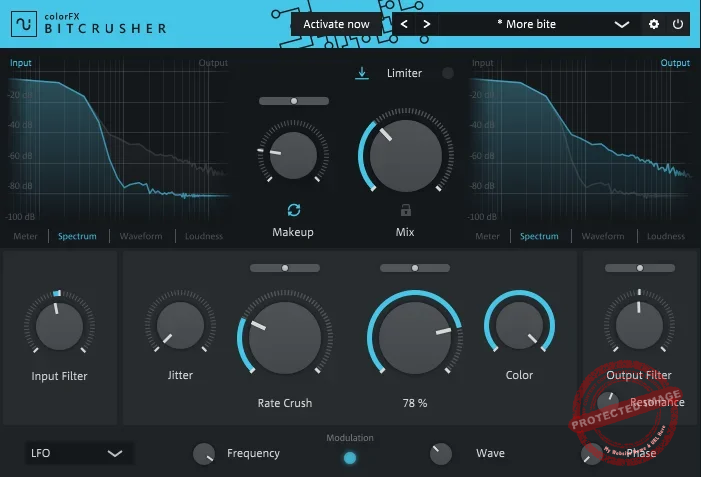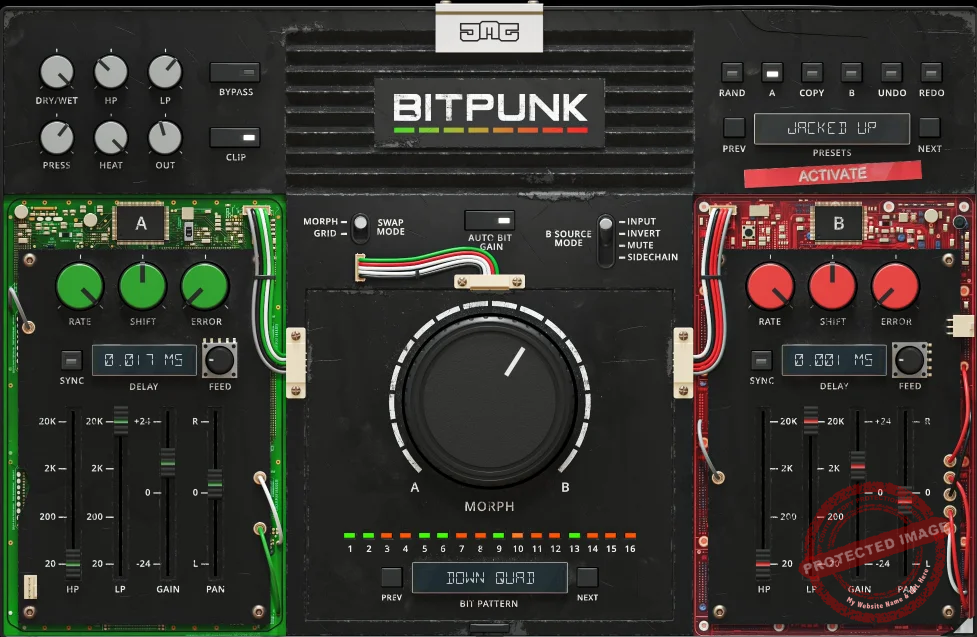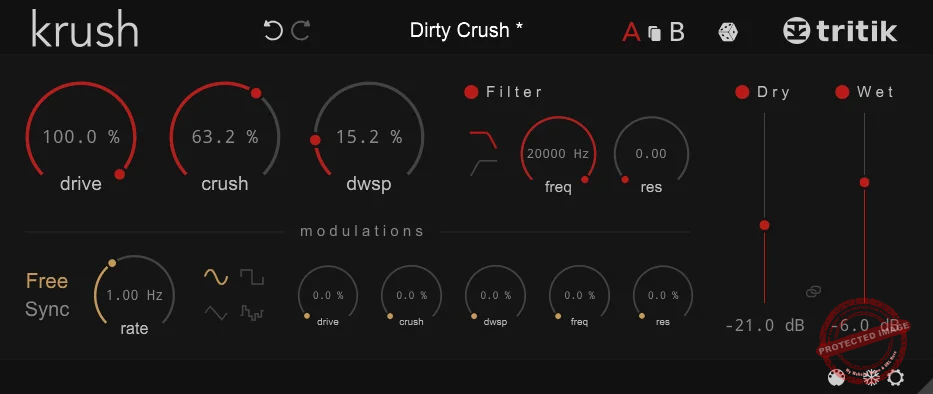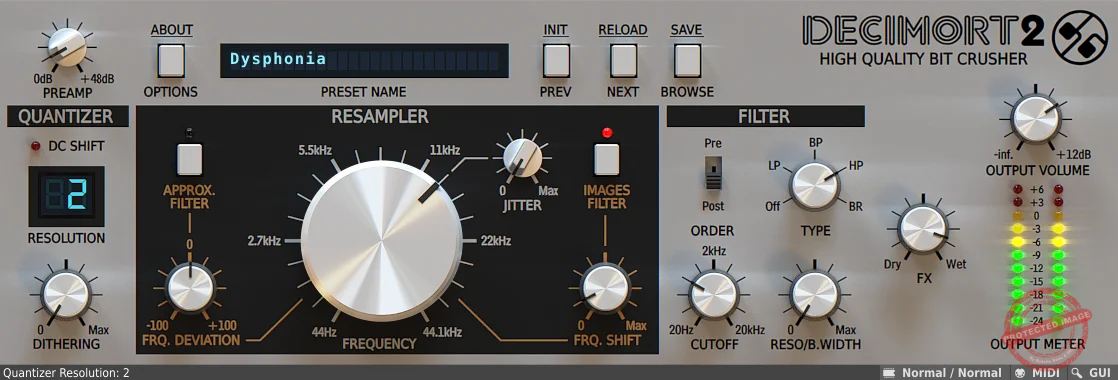Today, we take a look at some of the best Bitcrusher VST plugins to add that gritty sound to your mixes.
I use bitcrusher plugins to add more grit, character, or outright destruction to my sound. They’re for the producers who love to “experiment” and can introduce that lo-fi edge, crushing digital clarity, or creating textures that stand out in a mix.
Over the years, I’ve hunted and tried a few bitcrushers, and while some are straightforward, others offer layers of control that push creativity even further. Whether you’re into electronic, hip-hop, or experimental music, these plugins can bring unique characters to your mixes.
My experience has taught me that no two bitcrusher plugins are alike. Some differ in their sounds, some in their functionalities and interface, and each one of them offers something special, from intuitive interfaces to powerful sound-shaping tools. So, I will list these different plugins and share my experience working with them.
So, if you’re ready to inject some crunch, distortion, and digital madness into your projects, let’s explore what these crushers have to offer!
1. MAGIX colorFX Bitcrusher
What I find most interesting about the ColorFX Bitcrusher vst plugin is that it gives a new definition to digital distortion and gives you various forms of textures like gritty, crushed tones and subtle harmonic enhancements, so you can add different personalities to your sound.
- Precision Bit-Crushing Control
Well, ColorFX Bitcrusher simply just lowers the bit depth and sample rate of your audio to give it that lo-fi digital crunch. Its real strength lies in the degree of control over those parameters.
It is not flipping a switch for a generic bitcrusher sound; you are carving out exactly how much grit, crackle, and chaos you want in your music. Use it to degrade a vocal, add gritty texture to drums, or push a synth into experimental territory.
- Dynamic Modulation Capabilities
Bitcrusher’s modulation capabilities really stood out for me and gave me the freedom to link parameters to dynamic changes, making the distortion evolve with your track. That opens up opportunities for creating movement and tension, especially in genres like electronic, hip-hop, or experimental music. It’s also surprisingly useful for subtle sound design touches in more traditional mixes, where you might want just a hint of character without overpowering the track.
- Visual Feedback for Fine-Tuning
My favorite feature is the visual feedback tools here, like spectrometers and loudness meters, which are great for keeping things under control. You know that distortion can get muddy quickly; that’s why these tools are great for fine-tuning the effect without ruining the mixes. Still, I’d recommend caution when dialing in extreme settings; too much reduction can result in overly harsh sounds that might not sit well in a polished mix.
For anyone who loves exploring lo-fi aesthetics or experimenting with unconventional textures, this plugin, with its intuitive interface, multiple harmonic personalities, and versatility, encourages creativity without being overwhelming.
Available in VST2, VST3, and AU formats for both macOS and Windows.
2. United Plugins BITPUNK
Have you ever wondered what your audio might sound like if it were scrambled, crushed, or morphed at a microscopic level? That’s exactly what BITPUNK delivers: control over sound at its most fundamental, bit-level state.
- Advanced Bit-Swapping Engine
Let me explain to you how this works. Bitpunk bitcrusher vst breaks down audio into raw digital components and lets you manipulate those with its advanced bit-swapping engine, which allows you to swap bits between two audio signals. I know it sounds a bit complicated, but bear with me. This isn’t just adding noise, as it’s creating entirely new sonic textures by scrambling and rearranging the building blocks of sound.
- Versatile Effects and Frequency Shifting
In addition to bit-swapping, the plugin offers bit crushing, rate reduction, and glitch effects, so you can use the plugin to craft subtle digital warmth and chaotic, glitchy explosions as well. The frequency shifting option is another great feature, as it brings otherworldly dimensions to the audio. I feel like it’s bending time and space in the mix when I use it.
- Master Section and Dynamic Sidechain Input
The master section features compression, saturation, and hard clipping to polish your processed audio without extra tools. The sidechain input is a great addition, in my opinion, as it allows you to morph bits dynamically between two sounds. I’d recommend starting small with basic settings and gradually exploring the more experimental options.
However, there are some things you should be aware of, like the interface, which is visually creative but can feel overwhelming at first, especially if you’re new to bit manipulation. I’ll be honest: the learning curve is steep, and it’s easy to feel lost if you don’t start with the presets.
Another downside is its CPU usage, which can spike when using multiple effects at once. On older systems, this might cause some lag or crashes if you’re running a heavy session.
Available in VST, VST3, AU, and AAX formats for both macOS and Windows.
3. BeatSkillz S12X
Through the last years, vintage 12-bit drum samplers and old-school bit-crushing machines have found their way back to the music, as people love the nostalgic essence of the tracks for that “lo-fi” and “old-school” tones. S12X brings that 12-bit charm to your DAW.
- Authentic 12-Bit Sampler Emulation
The S12X bitcrusher stands out by sincerely emulating the distinctive pre-amp and filter characteristics of iconic 12-bit samplers. This isn’t just about adding noise or distortion; it’s about capturing the authentic warmth and grit that defined an era of music production. With the advanced neural network technology, the tool has to replicate these nuances; it creates a great emulation that is both accurate and musically pleasing.
- ‘Distrukt’ Control for Authentic Textures
One feature I found interesting was the ‘Distrukt’ control, which simulates the aliasing artifacts produced when samples are pitched up or down in vintage hardware. That adds a layer of authenticity, especially for genres like Lo-Fi, Synthwave, or 90s Techno, where such textures are highly valued.
- Flexible Signal Processing
The unit also offers input gain adjustment, allowing you to drive the signal into the emulated pre-amp for added saturation and wet/dry mix control, providing flexibility in blending the processed signal with the original.
You can use it on audio tracks, buses, and the master bus. Using it directly on virtual instrument tracks may cause pop/clicks due to the auto-gain feature, so I advise you to render MIDI tracks to audio before applying the S12X.
- A User-Friendly Vintage Charm
If you also want to add a touch of vintage 12-bit charm to your productions without the hassle of maintaining old hardware, the S12X could be a choice worth considering for its combination of authentic emulation and user-friendly controls.
Offered in VST3, AU, and AAX formats for both macOS and Windows.
4. Tritik Krush
I love that Krush takes the classic concept of bit-crushing and elevates it with modern features, offering a mix of lo-fi charm and dynamic control.
- Advanced Distortion with Resonant Filters
Tritik Krush is not just about reducing resolution or sample rate; this plugin adds depth with its analog-modeled resonant filters and a versatile modulation section, giving you complete control over the distortion.
- Flexible Modulation System
My favorite side here is the flexibility of the modulation system, as you can assign modulations to almost any parameter, so your sound gets movement and life! For example, you can change the filter cutoff or bit-depth dynamically over time with subtle fluctuations or wild rhythmic effects. It is useful for glitch, electronic, and experimental music, but really, you can use it anywhere if you want to get creative with your distortion effects.
- Blend Control and User-Friendly Design
You also get the dry/wet mix control, which allows you to blend the crushed sound with your clean signal and preserve clarity while still adding a layer of grit or crunch. The plugin’s interface is fully resizable, which I find really handy when juggling multiple plugins in a session. I know it’s a small touch, but it makes a difference.
That said, Krush isn’t without some quirks that can be dealbreakers for some. One thing to keep in mind is that it’s available only in 64-bit format, which might not work for those using older systems or DAWs. The modulation system, while powerful, can feel a bit intimidating if you’re not familiar with these types of controls. Starting with presets is a good way to learn, but there’s definitely a learning curve.
In my experience, Krush is at its best when used sparingly, as just a touch of downsampling on hi-hats or a subtle filter sweep on synths can transform a track. If you’re into more extreme effects, it can handle that, too. For anyone looking to add some creative edge to their mixes, this plugin is a solid tool.
By the way, note that Krush also comes with a paid Pro version.
Available in VST, VST3, AU, and AAX formats for both macOS and Windows.
5. Klevgrand Degrader
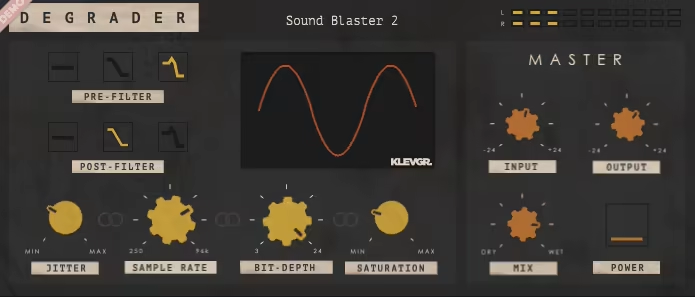
Degrader gives you deeper control over how your audio degrades from subtle lo-fi vibes to total sonic destruction and focuses on resampling and bit-depth reduction, but it doesn’t stop there. Its additional controls make it much more than your average bitcrusher VST.
- Powerful Sample Rate and Bit-Depth Controls
One of the standout features of Degrader is its sample rate reduction slider, which lets you choose how much resolution to strip away. This is perfect for creating a crunchy, digital sound reminiscent of old-school samplers or early computer audio.
Right alongside it is the bit-depth slider, which adjusts the resolution of the audio signal itself. Together, these two controls allow you to shape the texture of your sound, whether you’re after a warm, degraded feel or harsh, jagged distortion.
- Pre-and Post-Resampling Filters for Control
Most often, bit crushing artifacts are most apparent in the higher and the lower frequencies, which is why I really enjoy using the pre-and post-resampling low-pass filters, which help tame the high-frequency artifacts often introduced by resampling. The pre-filter is for rolling off frequencies before degradation, giving a smoother input, while the post-filter helps refine the sound after processing. This dual-filter setup is great for maintaining control and avoiding overly harsh or unbalanced results.
- Jitter Control for Organic Variations
I also love the unique Jitter control, which is responsible for adding random fluctuations to the sample rate. It allows you to create subtle, unpredictable variations in your sound, which replicates the malfunctioning hardware for more realism. I found it super fun to use as it gives an organic character and adds movement, especially on static sounds like pads or synth leads.
I must say while the interface is clean and easy to use, it lacks modulation options, meaning you’ll need to automate parameters externally for dynamic effects. Additionally, the plugin’s minimalist design doesn’t offer detailed visual feedback, which might make it harder for some users to fine-tune settings precisely.
My recommendation would be to use the pre-filter to soften harsh inputs before reducing bit-depth and experiment with Jitter for subtle harmonic complexity.
Comes in VST2, VST3, AU, and AAX formats for both macOS and Windows.
6. Denise Audio Bite Harder
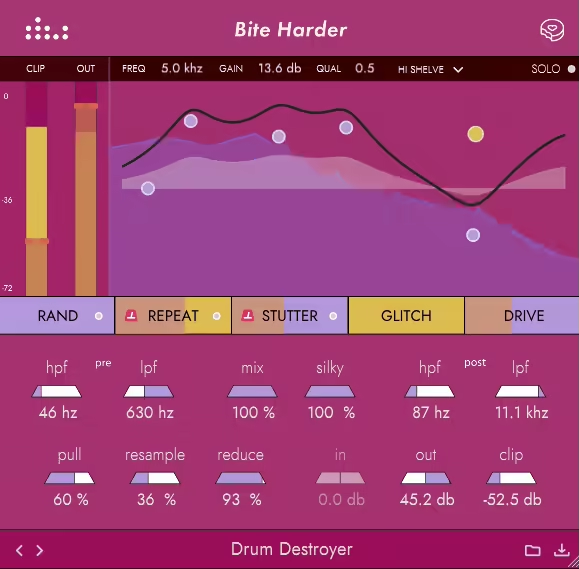
Bite Harder offers a suite of tools: Rand (randomizer), Repeat (repeater), Stutter (stutter), Gitch, and Drive, to add more “glitch” or time and pitch manipulation effects to them.
- Push-Pull Graph for Frequency-Specific Control
I love the overall aesthetic of the plugin, but one unique aspect of its interface that I find really engaging is the Push-Pull graph, which allows you to target specific frequency ranges for bit-crushing. That means you can apply intense distortion to certain frequencies while leaving others untouched, providing a high level of control over the effect.
- Silky Control for Polished Sound
Another thing I like about Bite Harder is the silky control, as it softens the harshness of bit-crushing. This lets you achieve a more polished sound even with extreme effects.
The unit is resource-intensive, though, especially when multiple effects are running simultaneously. This might impact system performance on less powerful setups.
You may find the Push-Pull graph more creative and awaken the “experimental sound designer” in you. Try out some of these presets first, then tweak parameters as needed to get a feel for what Bite Harder can do, and then go from there. The plugin is complex but rewarding if you dig into it.
Comes in VST, VST3, AU, and AAX formats for macOS and Windows.
7. BeatSkillz SampleX V3
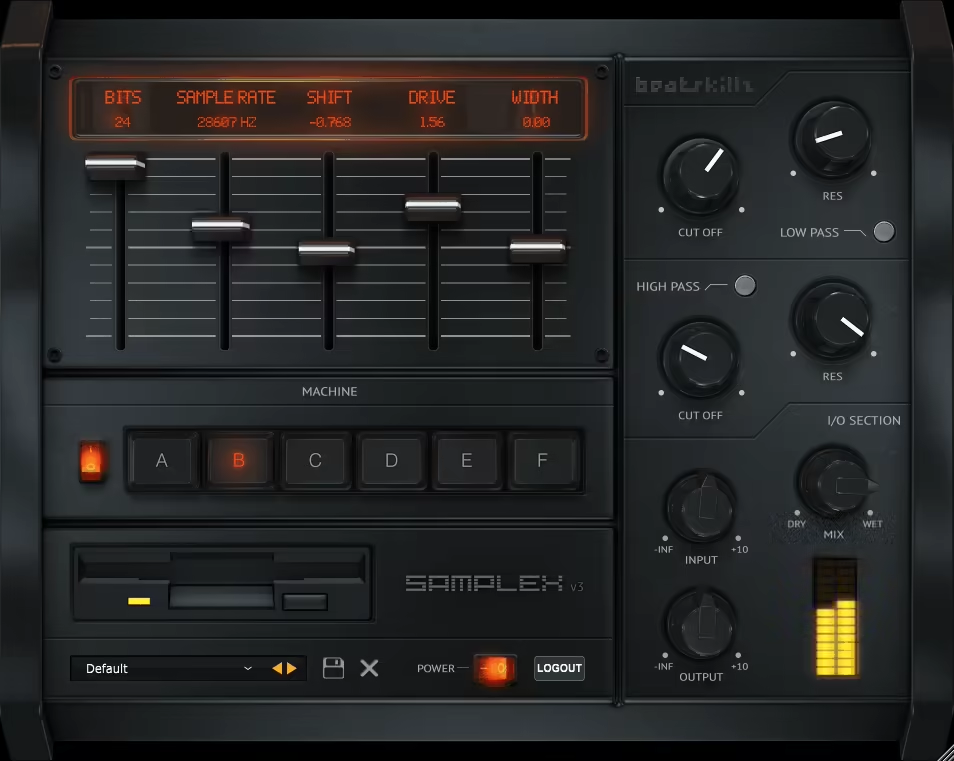
The first time I loaded up SampleX V3, I felt like I was holding a time machine for sound. Absurd thooight, right? But that’s exactly how it felt like. This plugin gives you the ability to replicate the character of vintage samplers down to their quirks and imperfections.
- Dynamic Convolution System
It uses something called a ‘Dynamic Convolution System,’ which uses six iconic samplers plugged directly into your DAW. I also liked the flexible sample rate and bit-depth controls, as you can push your audio as far as reducing the sample rate to a gritty 2 kHz or the bit depth to just 4 bits. To me, this opens up so much creative potential.
I’ve used SampleX V3 to give drum loops that crunchy, old-school vibe and even to break down synth pads into fragmented, glitchy textures. Numbers aside, this feature just feels inspiring because it forces you to think differently about how you treat sound.
- Filters and Stereo Width Control
Then there are the filters. I love the ladder-style low-pass and high-pass filters; they help me carve out harsh frequencies or accentuate the parts of the sound I want to keep. And let’s not forget the stereo width control, which helps you achieve both a mono punch and a wide, expansive feel.
Keeping my biases for the filters aside, let’s look at the negative sides. For me, the GUI is the biggest complaint. Though I eventually found my way around the interface, it took a bit of trial and error. I gotta say that it’s not something I’d call instantly intuitive.
I recommend pairing the sample rate reduction with subtle filter tweaks. Start by rolling off the low end, then drop the bit depth just enough to bring out those crunchy, lo-fi tones. It’s suitable for creating vintage hip-hop drum breaks or giving synths that nostalgic 90s vibe.
Available in VST3, AU, and AAX formats for macOS and Windows.
8. D16 Group Decimort 2
Decimort 2 offers a sophisticated approach to bit-crushing by emulating the unique coloration of vintage AD/DA converters.
- Quantizer and Resampler Sections
The Decimort 2 interface is divided into two main sections: Quantizer and Resampler, each offering detailed control over different aspects of the sound.
The Resampler section is focused on adjusting the sampling frequency, featuring a resampler knob that lets you sweep between 44Hz and 44.1kHz. This is complemented by the jitter parameter, which introduces random short-time fluctuations in the sampling frequency to impart an organic, analog-like warmth.
Additionally, a frequency deviation knob, ranging from -100 to 100, allows for further fine-tuning of these fluctuations, enabling nuanced and textured effects.
- Quantizer Tools for Digital Resolution
The Quantizer section provides tools for shaping the digital resolution of your sound, along with key controls like DC shift, resolution adjustment, and a dithering knob, which adds subtle noise to smooth out quantization artifacts.
- Multi-Mode Filter and Preamp
Beyond these two primary sections, Decimort 2 bitcrusher VST plugin also features a multi-mode filter with pre- and post-processing options, offering band-pass (BP), low-pass (LP), high-pass (HP), and band-reject (BR) filters for sculpting the frequency response. A preamp control is also included to drive and saturate the signal, adding warmth and intensity.
Offered in VST, AU, and AAX formats for both macOS and Windows.

Shaurya discovered his passion at the intersection of writing and music. Starting his career as a songwriter and rapper, he gradually picked up FL Studio and soon delved deep into the world of audio engineering and music production. Based in Delhi, India, he has worked with top studios, been featured on Red FM, garnered millions of streams on Spotify, and released music with major labels like Sony and Hitz.

